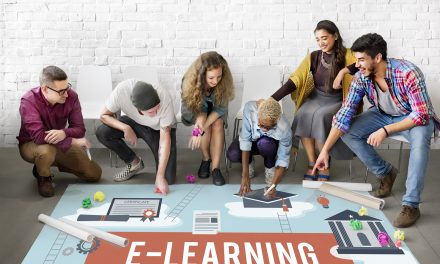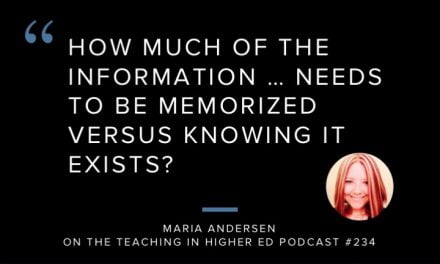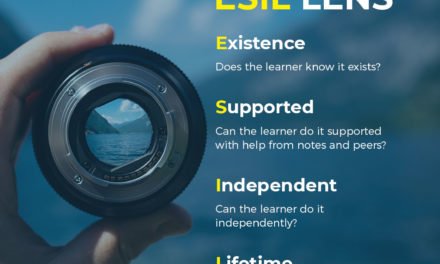I just realized I never posted the Recipe for Free Range Learning video from TEDxMuskegon. You can watch the video or you can read a rough transcript of the talk, posted below.
Here’s the text this talk was based on …
“Free range learning” describes the learning that takes place outside of the formal boundaries of education. I’ve been asked if the existence of “free range learning” implies that there is also some sort of “caged learning” as well. Well, the current U.S. education system was developed in the industrial era using the principles of a “factory model.” So, in a sense, you could call formal education a sort of “caged” system of learning, but I would prefer to think of it as a structured system with captive participants.
Free range learning has always been available in the form of books and journals, but with the rise of the Information Age in the last decade, free range learning is more widely accessible now. There are now many ways to learn outside of a formal education, but I want to help you to understand that it still takes some effort. There are steps you can take to be a more successful free range learner – there’s a recipe, if you will, for free range learning. The ingredients are information, the directions tell us to incorporate re-engagement, reflection, and social activity, cook it for sufficient time, and then make the final preparation – a learning challenge.
 Let’s start with this commonly-held belief that you can learn anything from the Internet. Efforts to duplicate non-digital information have been emerging all over the Internet. Wikipedia, with 3.7 million articles, has created a world encyclopedia translated into 270 languages. Project Gutenberg has digitized over 36,000 out-of-copyright books. When a book is still protected by copyright, projects like Google Books aim to at least make finding relevant books, and information stored withing those books easy to find. Universities and museums all over the world are digitizing collections of ancient texts to make these resources accessible to researchers, hobbyists, and learners.
Let’s start with this commonly-held belief that you can learn anything from the Internet. Efforts to duplicate non-digital information have been emerging all over the Internet. Wikipedia, with 3.7 million articles, has created a world encyclopedia translated into 270 languages. Project Gutenberg has digitized over 36,000 out-of-copyright books. When a book is still protected by copyright, projects like Google Books aim to at least make finding relevant books, and information stored withing those books easy to find. Universities and museums all over the world are digitizing collections of ancient texts to make these resources accessible to researchers, hobbyists, and learners.
We’ve replicated magazine and newspaper articles in digital formatting for web browsers, mobile phones, and tablets. We’ve replicated radio shows as podcasts and then created new streaming “radio stations” that exist only in the digital world. We’ve even digitized the “live lecture” circuit. In 2002, M.I.T. began the Open Courseware project with the online publication of fifty courses. Today there are more than 2,000 courses published on the MIT Open Courseware site and thousands of courses published by other colleges and universities that followed suit. Organizations like TED (in 2006) proved that spreading your ideas via video was more important than hoarding the “in-person” experience, and even on the private circuit, speakers began to warm to the idea of sharing video of their talks on the Internet.
Most of our Internet information-based activities only mimic that which was available in the non-digital world. But all of this information was never as accessible as it is now. So can you learn anything from the Internet? Well, if all it takes is information, we’ve now got that in abundance (unless of course, you need access to scholarly research journals – good luck with that). If you want to learn how to fix a sink, or how to use a feature in a Gmail, the Internet is a perfect teacher – search for a video, watch the video, replicate what you’ve been shown. For short task-oriented activities, the Internet can’t be beat. But if you’ve ever tried to learn a larger body of knowledge on your own, you might suspect it’s not as easy as simply having access to information.
Maybe you’ve experienced this before where you’ve said to yourself something like this, “I’m going to learn how to speak Spanish. I’m going to buy some software and I will spend a little time every day learning how to speak this language.” So you do it. You purchase the software … and then time passes. A year later, you find that box of Spanish software you purchased and you realize that you never even installed it on a computer. The intention to learn is there, but the follow-through is lousy. Chalk these examples up to a principle called optimism bias, when we overextend our beliefs about what we can actually accomplish. It turns out that access to information is a necessary, but not sufficient, requirement for learning.
Suppose you wanted to learn about the architecture of a computer system – what all the parts do, how they interact, the history of development of all the components, and then we want to be able to speculate on the future design of hardware components. That’s a much larger body of knowledge and you’re not going to get a deep understanding of computer architecture by simply reading or watching lectures on computer hardware. Consuming information is not the same thing as wisdom, understanding, and knowledge. When information becomes structured in our own minds in an interconnected way, we are able to do something useful with what we have learned.
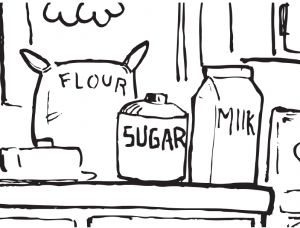 Back to the free range learning recipe. Every recipe needs to start with good quality ingredients, and so our learning recipe must start with high-quality information from reliable resources. Next we need a set of directions and the directions are very important. Imagine that I just hand you flour, milk, butter, chocolate chips and a few other ingredients and say “make chocolate chip cookies.” How many of you think you could do it? Not only would most of us be unsuccessful, but many of us would just give up without even trying. With access to so much information, we face the same problem for learning.
Back to the free range learning recipe. Every recipe needs to start with good quality ingredients, and so our learning recipe must start with high-quality information from reliable resources. Next we need a set of directions and the directions are very important. Imagine that I just hand you flour, milk, butter, chocolate chips and a few other ingredients and say “make chocolate chip cookies.” How many of you think you could do it? Not only would most of us be unsuccessful, but many of us would just give up without even trying. With access to so much information, we face the same problem for learning.
To learn a body of knowledge, you have to start by incorporating a base of information into your biological memory – this is necessary to even understand the taxonomy of a subject area. The research for how to do this is more than a century old. Ebbinghaus, in 1885, studied memory and found that when we learn something for the first time, our memory of that information drops off pretty precipitously unless we encounter it again. With each encounter, the slope of the forgetting curve lessens. And after multiple encounters, we reach a point where we are able to store it in our biological memories. To hold a conversation, to incorporate information into new ideas, to apply what you know to a practical situation, you must have a solid base of information to work from – you can’t simply “google” everything. So, you need to build this process of re-engagement into your free-range learning project. New ideas and innovations come from a marinade of old ideas with new information. It’s seeing something that you thought about three years ago together with some new information that actually creates the innovation. This process of re-engagement turns out to be one of the hardest directions to follow, and I’ll talk more about the practicality of this direction towards the end.
The next step in the directions for free range learning is to find a way to incorporate reflection. Reflection helps you to synthesize information and connect it to other threads of knowledge you already hold in memory. One common way to reflect is to write – to collect cohesive thoughts about what you’re learning and to share them with others. Many of us write blogs for this one reason – it forces us to think carefully about what we’ve learned and incorporate the new information into our existing body of knowledge and worldview. What’s interesting about blogging is that you’ll find yourself reading your own blog posts again and again. The subject was interesting to you when you wrote it, and it will continue to hold your attention when you re-read it.
If you’re not much of a writer, consider finding someone to teach what you’re learning. Teachers will tell you they learned more in the first time they taught a course than in all the courses they taught up till that point. Teaching is an activity that forces you to reflect on what you’re learning. Find someone who knows less than you do, and set up a standing appointment to meet with them once a week and them everything you’re learning.
Reflection can also be a very non-structured activity. Some of my best ideas (and probably yours too) come in the shower, sitting in airplanes, or exercising (for me this is swimming laps at the pool). When the mind is free to wander, our brains begin to connect up bits of information. Dedicate some “down time” to think about what you’re learning. When I swim laps, I try to focus on some problem I’m trying to solve, or some idea that needs some refining. Breakthroughs can come when you remove all the other distractions from the world and when there’s a little white noise to block out new distractions (the water in the shower, the hum of the engines, or the wind in the trees). You need to give your mind a chance to wander and see what it can discover on its own.
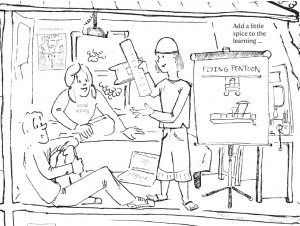 After the re-engagement and the reflection, we need to add a little “spice” to the learning. Spice is used to flavor food – to make it more enjoyable and interesting to the palette. In the same way, we need to make the learning more palatable and enjoyable to the brain. We do this by adding a little sprinkling of social interaction. You’ll need to find or create a learning community focused on the subject you are trying to learn. This can be as easy as plugging in to the right social network. For those of us who use Twitter as a professional network, we choose who we follow by looking for who is learning that which we want to learn too. I follow those people that I learn from on a regular basis. Hacker spaces and maker spaces create a physical community where learners meet to share their ideas and teach each other new things. Your social learning community might be a group that meets regularly for a book discussion or a friend you have lunch with where you can discuss new things you’re learning.
After the re-engagement and the reflection, we need to add a little “spice” to the learning. Spice is used to flavor food – to make it more enjoyable and interesting to the palette. In the same way, we need to make the learning more palatable and enjoyable to the brain. We do this by adding a little sprinkling of social interaction. You’ll need to find or create a learning community focused on the subject you are trying to learn. This can be as easy as plugging in to the right social network. For those of us who use Twitter as a professional network, we choose who we follow by looking for who is learning that which we want to learn too. I follow those people that I learn from on a regular basis. Hacker spaces and maker spaces create a physical community where learners meet to share their ideas and teach each other new things. Your social learning community might be a group that meets regularly for a book discussion or a friend you have lunch with where you can discuss new things you’re learning.
The learning community is vitally important because they will also push out reminders via social cues: reminders to meet with the group, Facebook posts about upcoming events, or tweets pointing you to good resources on your topic of interest. If you begin to fall through the cracks on your learning project, your social network might just pull you back on track. But more importantly, there’s nothing better than a human social network to point you to new resources, ideas, and connections. If you want to learn about computer architecture, start following some computer engineers on Twitter. Every time you see an unknown term used in their tweets, you’ll be reminded that you have something to learn, you’ll go look up the term, and you’ll think about how to connect it to the rest of what you have already learned.
So far, the directions for free range learning tell us to re-engage, reflect, and add some of the spice of social activity, but sufficient “cooking time” is also important. Learning a body of knowledge needs a significant time investment. In the book Outliers, Malcolm Gladwell proposes that you need to spend 10,000 hours to become an expert in a subject area. Just to give you a rough idea, a college degree from start to finish should take somewhere in the neighborhood of 2500 to 4500 hours. But a college degree is not highly specified until the last year or two. So at the end of a college degree and your whole K-12 education, you’ve got between 1,000 and 3,000 hours invested on this 10,000 hours requirement. What this tells us is that even with a college degree, you still have to keep learning if you want to become an expert in your field one day.
The importance of time-on-task can’t be underestimated, but it’s hard to stay on track. Recently I completed my dissertation, which is the ultimate free-range learning activity, if you ask me. When you are ready to write your dissertation, you stop taking classes. There are no more regular meetings and assignments to push you to completion. You have to learn, conduct research, and write about a very specific body of knowledge is completely and your time is totally unstructured. Data from the PhD Completion Project shows that roughly 30-60% of PhD students actually complete their dissertations within a 7-year time period. That means 40-70% fail at this task of free range learning, even though they were successful learners in the structured educational environment. You could say that a dissertation is a test of whether you have learned how to learn within the boundaries of Academia. When I wrote my dissertation, I tracked every hour I spent by sending a tweet to my social network on Twitter. I figured that the key to writing a dissertation was just to keep focusing on the next hour of learning. With enough hours invested, I figured I would eventually finish, and I did. Too many would-be PhDs get so overwhelmed by the task in front of them that they just spend all their time thinking about what they have to do. How do you eat an elephant? One bite at a time.
 Now we have the ingredients, the directions, and the cooking time, but there’s one final step. To be successful in a learning project, you have to set up some kind of final learning challenge (or series of challenges). These should be goals that are not easy to postpone. This is, incidentally, why formal education works. Stop and think about how much you would have learned in school if your papers didn’t have due dates or your tests weren’t scheduled by your instructor. A deadline creates just the right amount of stress to force a synthesis of information into a body of knowledge (assuming the procrastination hasn’t been too bad). I often sign up to give a presentation about 9-12 months away on some topic I don’t know enough about. The pressure of the “scary deadline” keeps me focused and learning throughout the next year. In preparation for the presentation, I have conversations with others about the topic, I read books and papers on the topic, I watch videos about the topic, and I blog about it. In the final weeks, I am forced to organize all these thoughts and ideas into some kind of coherent body of work in order to “teach” others what I’ve learned.
Now we have the ingredients, the directions, and the cooking time, but there’s one final step. To be successful in a learning project, you have to set up some kind of final learning challenge (or series of challenges). These should be goals that are not easy to postpone. This is, incidentally, why formal education works. Stop and think about how much you would have learned in school if your papers didn’t have due dates or your tests weren’t scheduled by your instructor. A deadline creates just the right amount of stress to force a synthesis of information into a body of knowledge (assuming the procrastination hasn’t been too bad). I often sign up to give a presentation about 9-12 months away on some topic I don’t know enough about. The pressure of the “scary deadline” keeps me focused and learning throughout the next year. In preparation for the presentation, I have conversations with others about the topic, I read books and papers on the topic, I watch videos about the topic, and I blog about it. In the final weeks, I am forced to organize all these thoughts and ideas into some kind of coherent body of work in order to “teach” others what I’ve learned.
This is the kind of thing you have to set up to ensure you complete your learning project. The deadline cannot be easily postponed. If it’s a language you’re learning, buy a plane ticket to visit a country where the language is spoken. If you want to learn about solar energy, sign up to display your solar-powered tractor at next year’s Maker Faire. If you want to learn to play an instrument better, commit to playing it in an event at your church next year. Without the structure and pressure of an educational system to keep you motivated, you need to provide that pressure yourself.
So is free range learning possible? Yeah, of course it’s possible, but it’s going to require some work. Just like going to school requires some hard work. Free range learning is not a free ride. To learn about subjects like game design and learning analytics I’ve had to be self-motivated. I read a ton of new information, I tweet when I learn something new, I write blog posts to reflect about what I’m learning and I place myself in social networks where information and resources comes to me. Nobody rewards me for these activities – nobody gives me assignments to do or gives me a grade to assess my progress. My progress is measured by the feedback I get when I write or present about my ideas, and those activities too, are completely self-motivated.
To become better free range learners, we need an easy way to indicate what we’d like to be learning and an easy interface that rewards us for good learning behaviors. We need a new media layer on the Internet that is specifically for learning.
[Now see “Where’s the Learn This Button?“]


